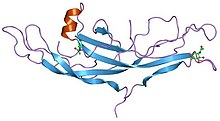Cystine knot
| Cystine-knot domain | |||||||||||
|---|---|---|---|---|---|---|---|---|---|---|---|
 Structure of human chorionic gonadotropin.[1] | |||||||||||
| Identifiers | |||||||||||
| Symbol | Cys_knot | ||||||||||
| Pfam | PF00007 | ||||||||||
| Pfam clan | CL0079 | ||||||||||
| InterPro | IPR006208 | ||||||||||
| SCOP2 | 1hcn / SCOPe / SUPFAM | ||||||||||
| |||||||||||
A cystine knot is a protein structural motif containing three disulfide bridges (formed from pairs of cysteine residues). The sections of polypeptide that occur between two of them form a loop through which a third disulfide bond passes, forming a rotaxane substructure. It occurs in many proteins across many species and provides considerable structural stability.[2][non-tertiary source needed] There are three types of cystine knot, which differ in the topology of the disulfide bonds:[3]
- The Growth Factor Cystine Knot (GFCK)
- Inhibitor Cystine Knot (ICK) common in spider and snail toxins
- Cyclic Cystine Knot, or cyclotide
The growth factor cystine knot (GFCK) was first observed in the structure of Nerve Growth Factor, solved by X-ray crystallography and published in 1991 by Tom Blundell in Nature.[4] All GFCK structures that have been determined are dimeric, but their dimerization modes in different classes are different.[5]
References
- ^ Wu H, Lustbader JW, Liu Y, Canfield RE, Hendrickson WA (June 1994). "Structure of human chorionic gonadotropin at 2.6 A resolution from MAD analysis of the selenomethionyl protein". Structure. 2 (6): 545–58. doi:10.1016/s0969-2126(00)00054-x. PMID 7922031.
- ^ http://www.cyclotide.com/knots.html
- ^ Daly, N. L.; Craik, D. J. (2011). "Bioactive cystine knot proteins". Current Opinion in Chemical Biology. 15 (3): 362–368. doi:10.1016/j.cbpa.2011.02.008. PMID 21362584.
- ^ PDB: 1bet; McDonald NQ, Lapatto R, Murray-Rust J, Gunning J, Wlodawer A, Blundell TL (December 1991). "New protein fold revealed by a 2.3-A resolution crystal structure of nerve growth factor". Nature. 354 (6352): 411–4. doi:10.1038/354411a0. PMID 1956407.
- ^ Jiang X, Dias JA, He X (Aug 2013). "Structural biology of glycoprotein hormones and their receptors: Insights to signaling". Mol Cell Endocrinol. 382 (1): 424–51. doi:10.1016/j.mce.2013.08.021. PMID 24001578.
